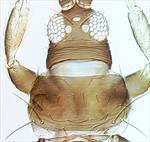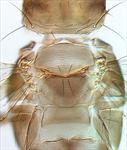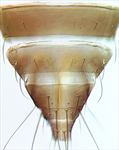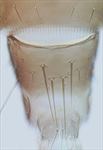
Female

Head & pronotum

Antenna

Pro, meso & metanota

Tergites IV–VI

Tergites VII–X

Sternites V–VII

Male sternites

Male tergites VIII–IX

Fore wing
Female macropterous. Body colour brown, tarsi yellow, tibiae variable but yellow at least at apex although sometimes almost clear yellow; antennae brown with apex of segment III yellowish; fore wings brown with base pale. Antennae slender, 8-segmented, III & IV each with apex narrowed and bearing forked sense cone. Head longer than wide, projecting slightly in front of eyes, cheeks convex but constricted behind eyes; posterior part of vertex transversely striate/reticulate, ocellar region without sculpture; 2 pairs of ocellar setae present, pair III as long as distance between compound eyes and arising on tangent between anterior margins of hind ocelli; postocular setae small. Pronotum without sculpture, with few discal setae, 2 pairs of long posteroangular setae; posterior margin with 2 pairs of small setae laterally and 1 pair of larger setae medially just in front of posterior margin. Fore tarsal pulvillus without recurved terminal tooth. Metanotum weakly reticulate, campaniform sensilla present, median setae arising close together at or near anterior margin. Mesofurca with spinula. Fore wing first vein with 1 seta medially and 2 nearer apex; second vein with complete row of about 10 setae. Tergites with no sculpture mesad of setae S2; VIII with posteromarginal comb of long regular microtrichia. Sternites without discal setae, setae S1 and S2 on sternite VII arising in front of margin.
Male smaller than female; tergite VIII with complete long comb, IX with 2 pairs of long dorsal setae with the lateral pair arising anterior to the median pair; sternites III–VII with broad pore plate.
There are 30 species listed in the genus Taeniothrips, together with a further 21 that are known only from fossils. Three species are European in origin, one is from western North America, and the rest are from Asia. The western North American species, T. orionis, is particularly similar to T. major Bagnall from the Himalayan region of northern India and Pakistan. In the European species T. picipes antennal III is considerably paler, and T. inconsequens has a terminal claw on the fore tarsus, and the metanotal median setae further apart.
Breeding on the leaves, but also found on bulbs and in flowers, of various species of Liliaceae and Amaryllidaceae, including Crinum, Eucharis, Hymenocallis, Liriope, Lycoris, Narcissus, Zephyranthes. This thrips sometimes causes a small amount of discolouration around the leaf bases of lilies. It is recorded as a vector of a tospovirus in southern China (Xu et al., 2017).
Although described originally from Bermuda, this species is from eastern Asia and is recorded from Korea, China, Taiwan, Malaysia, Japan, Hawaii, northern Australia and the Netherlands (Mound & Tree, 2008). It is likely to be introduced to California by the horticultural trade in lilies.
THRIPIDAE - THRIPINAE
Taeniothrips eucharii (Whetzel)
Physothrips eucharii Whetzel, 1923: 30
Taeniothrips gracilis Moulton, 1928: 289
Taeniothrips rohdeae Kurosawa, 1937: 273.
Mound LA, Azidah AA & Ng YF (2012) Key to the non-fossil species of the genus Taeniothrips (Thysanoptera, Thripidae). Zootaxa 3414: 33–42.
Mound LA & Tree DJ (2008) The oriental lily-flower thrips, Taeniothrips eucharii (Whetzel) (Thysanoptera: Thripidae) new to Australia. Australian Entomologist 35: 159–160.
Xu Y, Gao X, Jia ZQ, Li WG, Hu J, Li YZ, Liu YT (2017) Identification of Taeniothrips euchariae (Thysanoptera;Thripdae) as a vector of Hippeastrum spotted ringspot virus in southern China. Plant Disease 101: 1597-1600. doi.org/10.1094/PDIS-01-17-0045-RE